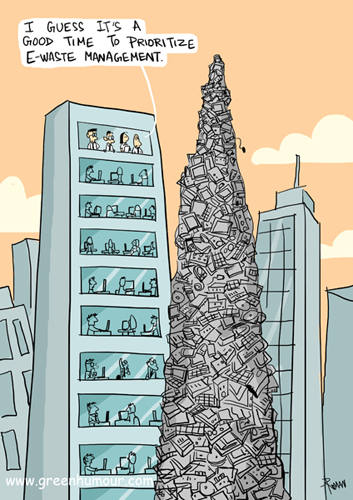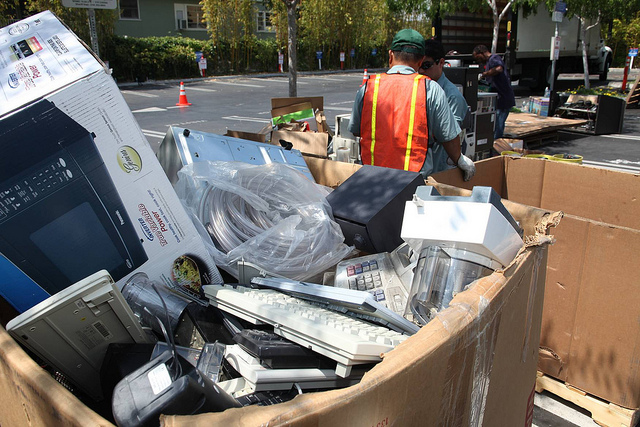Can you cut 1 Tonne of carbon pollution out of your life?
Take the challengeWe've been answering your toughest sustainability questions! Ask us via Facebook, Twitter or email.
Here are a few similarly themed questions we received asking about the ins and outs of E-Waste, so we've compiled an article with our sustainable solutions.
Bronwyn David asked:
"What do we do with broken down electrical devices? e.g. I have a portable CD player that no longer reads CDs. Bulk rubbish collections usually (in my area) prohibit electrical goods being left out."
Amy Mclellend asked:
"I have an old and broken laptop. The parts aren't even worth harvesting. Is there some way I can dispose of it in a sustainable way?
Claudia Vinson asked:
"Where can we recycle old cables from old electronic items. Places tend to take the items (like cameras) but not the cables."
These are great questions! Sustainably disposing of E-waste can be a confusing area with no blanket answers. Whilst easy solutions may be challenging, we can't afford to ignore this problem. Well done Bronwyn, Amy and Claudia for asking these important questions!
The E-Waste Problem:
E-waste is electronic equipment that has reached the end of its useful life. It's your flat screen TV's, laptops, phones and not to mention their accessories such as cables, batteries, chargers and cords.
E-Waste in land-fill is hugely costly to the environment. E-waste which has been sent to landfill often contains toxic chemicals such as lead, mercury and arsenic which can seep into soil, contaminate water reservoirs, and even make it into the food chain. Additionally, the production of electronic goods is a carbon-intensive process that, at current levels, our fragile planet simple cannot accommodate. The more we waste, the more the demand for brand new goods.
Here are some shocking E-waste fast facts from Clean Up that put the issue in perspective:
- 75% of the 3 million computers bought in Australia every year will end up in landfill.
- In 2007/8, 16.8 million computers reached their end of life. Of this, only 9% will be recycled.
- Electronic waste is responsible for 70% of the toxic chemicals such as lead, cadmium and mercury found in landfill.
- E-waste is being sent to landfill at three times the rate of general waste.
Image credit: Green Humour

Be A Conscious Consumer:
Before delving in to E-waste disposal, let's take a step back and consider the impact on our planet before a purchase is made. Before you buy:
- Ask, do I need this? Often, the answer is no!
- Do I need to buy this new? Admittedly, some electronic items such as phones and computers are considered essential in today's modern world. Perhaps think about swapping, borrowing, or renting your electronic goods.
- If you must buy a new product, avoid disposable products as much as possible. Try to look for durable items that have warranty. Also try to consider the ethical footprint of the item. There are some great apps than are super helpful for this process.
Image: Flickr

How To Sustainably Dispose of E-Waste?
Fast-forward to a few (hopefully many!) months/years post-purchase. Your electronic product has come to the end of its life and it needs to go. What to do?
For Still-Working Electronic Items:
- Ask your family and friends if they need a second-hand electronic item. A good way to do this would be to post on social media.
- Call up a local school/community support service and ask if they'd like the product.
- This online resource will give you a guide to charities that accept electronic goods in Australia.
For Broken/Damaged Electronic Items:
- Amy asked about disposing of an old, broken laptop.The good news is, in Australia, there is a scheme under which companies which produce over a threshold of televisions and computers per year are required to pay for the recycling of the products. There are 4 services that operate within this scheme, including TechCollect, Drop Zone, E-Cycle Solutions and Sims Recycling Solutions.
- Bronwyn asked about how to dispose of general electrical devices. She is correct in saying that e-waste should/cannot go into bulk rubbish collection, or even general recycling. Luckily, there are many services now that exist to provide recycling options for e-goods. Planet Ark has a service which can tell you recycling operators near you. Check the website of the service or give them a call to arrange to dispose of your e-waste. Sometimes this may involve a small fee, but usually it's free of charge.
- Claudia asked about recycling cables and cords. Unfortunately, this is appears to be a sometimes difficult e-product to recycle, but certainly worthy of an attempt. The difficulty arises due to the high percentage of PVC in many cables. Once again, check the Planet Ark online service or do a google search to find an e-waste recycler near you. Some accept cords, some don't. Check their website or give them a call to see if they accept electronic cables and/or cords. It's also worth considering donating cables and cords that are in good condition to businesses, schools or nonprofits. If all else fails, try giving the cords/cables away via Gumtree or Craigslist (if you're in the states), or selling the cords to a scrap metal place who will at least re-use the metal (but not the plastic). Lastly, if you're a creative type, be inspired by this designer who has turned electrical cords into stunning jewellery!
Image Source: Inhabit


